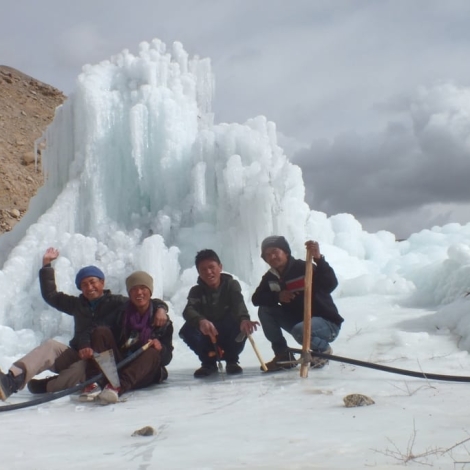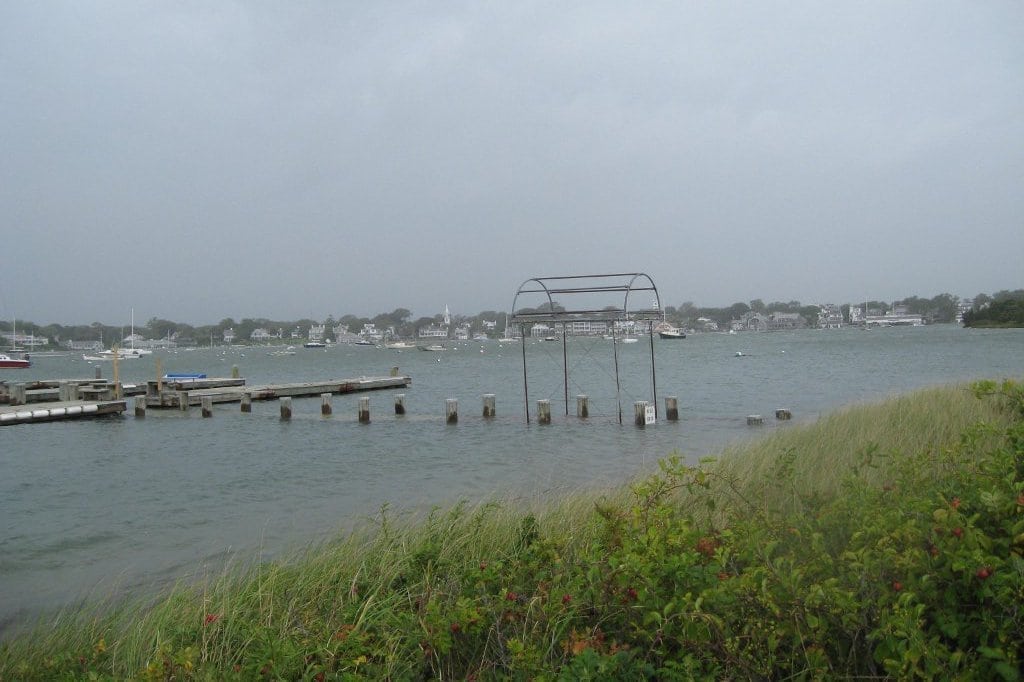Generations of farmers in the high desert of Ladakh have planted in the spring when glacial melt water begins to flow from the Himalayan foothills above them. In recent years, however, the weather has gradually warmed and the glaciers are shrinking, leaving the soil dry.
“Shrinking glaciers are a known phenomenon here. In the people’s lifetime they have shrunk by up to a kilometer. So a decrease in melt water is only natural. There are some villages that are being abandoned, even. Perhaps [they are] the first climate-change refugees,” Sonam Wangchuk, a mechanical engineer and instructor at the SECMOL school in Ladakh told E4C.
Engineers had tried to artificially build up the glaciers above the farming villages. They diverted waterways to create high-altitude ice fields on north-facing slopes in the shade of peaks. But the work was strenuous and required steep climbs to maintain the water diversions. Wangchuk had a simpler plan. He piped water through a gravity-fed tube from winter streams to a patch of land right in a farming village. The water froze in an icy cone that grew to contain 150,000 liters. Its shape resembled a “stupa,” a religious shrine made of stacked rock and that is what Wangchuk calls it, an “ice stupa.” The conical shape left little area exposed to the sun, so it melted slowly during the spring to irrigate the surrounding fields.
“Lima has given new urgency towards fast tracking adaptation and building resilience across the developing world” – Manuel Pulgar-Vidal, Minister of the Environment of Peru, in a statement at the United Nations Framework Convention on Climate Change in Lima in December, 2014
After that success, Wangchuk launched an Indiegogo campaign to pay crowdfund the construction of more ice stupas. He raised $125,000 by the time the campaign closed in December, 2014. Wangchuk parlayed an astutely managed online fundraising effort and a low-cost artificial glacier-buildling technique into a lifeline for Ladakhi farmers. Ice stupas are an example of the inventive ways that developing communities worldwide are adapting to climate change.
Climate change adaptation is now a major focus of development programs and investment. Global talks such as the recent conference in Lima, Peru, in December 2014, have historically centered on cutting emissions, but they have now raised adaptation technologies to prominence.
While the basic facts of climate science are debated in sheltered corners of the world, the towns that are buffeted by storms, flooded by rising seas and storm surges, threatened by landslides, flooding and drought are building now to live with a changed environment. Poverty exacerbates their plight. But good planning, land management and relatively low-cost technologies may ease the pain for the next few decades. These are the broad threats from climate change today, and how engineers are responding.
[See our report, 10 technologies developing countries are using now to adapt to climate change]
People in flood zones are learning to live with water – Jennifer Sara Director of Water Global Practice for the World Bank
Flooding
A changing climate brings heavier rains and new, unpredictable weather patterns. Coupled with poor infrastructure choices, coastal and riverside communities are flooding. In response, people are learning to live with water, says Jennifer Sara, Director of Water Global Practice for the World Bank.
That means building homes that are propped up out of the way of flood water. And no more building in flood zones, which might seem obvious but it remains a problem.
Putting a green space in a flood zone can absorb the water and recharge drinking water aquifers, Sara says. Another way to live with water is to build streets and sidewalks out of porous materials that let the water soak into the soil.
The first reaction is often to build infrastructure, but there are non-structural solutions, Sara says. With her help, coastal flood zones in Ho Chi Minh City, Vietnam, have been able to weather storms more easily after properly maintaining the infrastructure that they already have. Cleaning drains and dredging canals, coupled with new zoning laws and land management have reduced the impact of the floods.
Flood-prone communities also need disaster warnings. That may be sirens, text messages or radio, for example, and they should coincide with a practiced action plan.
[See our Solutions Library for more on flood-resistant housing]
Nature is an efficient buffer against an angry sea, and safe coastal development needs to include space for it.
Storm surges
NASA reported in January that 2014 was one of the three hottest years since measurements began in 1880, and the 10 hottest years in that period have occurred since 1998. The average global surface temperature has increased .09°C (.15°F) per decade. As the weather warms, glaciers melt and the seawater expands, raising the sea level 20cm (nearly 8in) since 1870. By 2100, the sea is projected to rise as much as 30 – 120cm (1 – 4ft). The warmer water strengthens storms, battering coastal communities with a higher waterline and bigger waves.
In response, Asian and Central and South American countries are planting mangroves. That is one of the ways that people can minimize the damage from surging waves through ecosystem management, according to the Intergovernmental Panel on Climate Change’s latest report in 2014.
Nature is an efficient buffer against an angry sea, and safe coastal development needs to include space for it. Mangrove forests trap soil that would otherwise wash into the ocean and help dissipate the power of waves surging on shore. Coral reefs can serve as a kind of natural seawall, but a warmer, dirtier and more acidic ocean is killing them off.
“I believe in a society that has successfully launched a robot to Mars and put man on the moon. If you believe in this society, then you should also believe that this society is capable of finding solutions to climate change” – Netra Chhetri Senior Sustainability Scientist at the Julie Ann Wrigley Global Institute of Sustainability and an associate professor at Arizona State University in Tempe
In the island country of Guam, volunteers have worked hundreds of hours to protect their coral reefs from the rising threats of a changed climate. Through the Humåtak Project, community groups are installing sediment filter socks on eroding slopes and planting trees to restore watersheds and reduce the sediment runoff that kills coral. With healthy reefs, the fishing is much better, too.
Landslides Add heavier rains in a changing climate to slash-and-burn farming and deforested slopes, and the sad result is the sudden burial of homes and neighborhoods. Communities protect themselves by reforesting and reducing the need for wood. They can use efficient stoves and water treatment devices instead of open fires for cooking and boiling water.
Also, an early warning system is in the works. Researchers at the University of the Philippines are developing a landslide sensor based on an accelerometer and a moisture sensor packed into a tube.
[See our report, The next generation of technology for disaster preparedness and relief]
Drought
Farmers in drought-prone regions have always struggled, but changing weather patterns are making it worse.
“Loss of water and springs is probably the one that we have noticed in the early stages of climate change. People are losing their source of water because of the melting of snow and migration of snow line to higher elevations,” says Netra Chhetri, Senior Sustainability Scientist at the Julie Ann Wrigley Global Institute of Sustainability and an associate professor at Arizona State University in Tempe.
“Limiting the effects of climate change is necessary to achieve sustainable development and equity, including poverty eradication” – Intergovernmental Panel on Climate Change 2104 report
Artificial glaciers are answering the problem in Ladakh, and low-cost irrigation is boosting crop yields on other farms worldwide. An irrigated farm produces twice as much food, but only 20 percent of the world’s farms are irrigated. iDE reports high numbers of sales of drip irrigation systems and human-powered treadle pumps. Old-fashioned diesel pumps have been the go-to engine for farmers who can afford them, but competition is underway in India to design a viable solar-powered pump to replace them.
Greenhouses can smooth out the rough edges of a growing season. Greenhouse farmers can grow crops year round, their crops grow more than twice as quickly and require only two-thirds of the water of outdoor farms.
And finally, farmers fight the weather with drought- and salt-resistant crop varieties.
New appreciation for indigenous solutions
Houses on the shore of the Amazon River Iquitos, Peru, are built on log platforms that float when the river rises. Those kinds of traditional solutions to weather problems have attracted interest in the search for answers to climate change. Traditional knowledge is a “major resource for adapting to climate change,” according to to the IPCC’s report.
“There’s a great realization that traditional agricultural practices implemented by farmers in harsh and marginal climates may be worth reconsidering. It’s an acknowledgment of the value of local knowledge and local practices in response to a changing climate,” Chhetri says.
The future
Wealthy countries can afford massive infrastructure solutions like seawalls and levees, and they can even afford to put off some of those solutions for a few more years. But some of the world’s poorest people already feel the effects. Softening the blow of climate change is necessary for sustainable development and ending poverty, the IPCC says.
From now on, engineering for global development needs to take a future of harsher climates into account.

